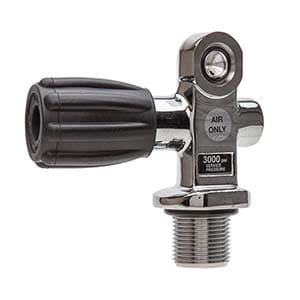Private Scuba › Diving › Equipment › Cylinders › Valve Thread Mismatch
Mismatched Cylinder and Valve Thread
One of the key standards for diving cylinders is matching the thread size of scuba valves with the same thread size of cylinder outlets.
This important information explains what can happen when someone attempts to insert mismatched valve threads into the wrong size dive tank neck.
Valve to Cylinder Mismatch Can be "Deadly"
In fact, diving deaths statistics show that cylinder valves and accidents in scuba diving are not common.
Even so, talk to any trained technician about mismatching scuba valves to cylinder outlets and they will be rightfully concerned!
But, that's exactly what happened in Europe [2022] when a scuba tank explosion resulted in a fatality.
In a nutshell, it happens because diving cylinder valve connections are not the same worldwide. As a result, the fundamental variances create confusion - which sometimes leads to fatal accidents in diving.
So, why isn't the issue preventable? In fact, regulators have already set in place several procedures to avoid scuba cylinder and valve thread size mismatch.
First of all, having a basic understanding of the relationship between cylinder thread sizes and scuba tank valves is key. In addition, undergoing function-specific training is another essential part of the process.
What Causes Mismatching Valve Threads?
The ¾-inch National Pipe Straight Mechanical (NPSM) with 14 threads per inch (TPI) is the standard cylinder neck thread in the United States.
By comparison, the common metric neck thread for scuba cylinders is the M25 x 2 – ISO with 12.7 TPI. Yet, calling the metric an "equivalent" to a ¾-inch NPSM is incorrect.
Here's the thing:
Mismatches happen when an untrained (or inexperienced) person starts to insert a scuba valve with a M25 thread into a ¾-inch NPSM cylinder neck.
The issue will worsen because it will seem like it's going to fit, albeit with a need for some force to tighten it. Plus, because it won't seal in the correct manner, there may be further need to over tighten the assembly.
In case you were wondering. An M25 threaded valve will also seem like it fits a ¾-inch British Standard Pipe (BSP) cylinder. But, during this somewhat robust procedure, doing so will damage the incompatible thread forms.
Pro Tip: Sometimes, scuba tank markings may be unclear or missing altogether. In this case, the prudent scuba engineer would use a specialist thread gauge (or thread checker) to verify the threads on the valve and cylinder neck are compatible.
What's the Backstory?
Almost all U.S. scuba cylinders were ½-inch National Gas Tapered (NGT) threads up to 1958. Following a gradual transition to the parallel ¾-inch NPSM, it became the accepted standard for scuba tanks in the early 1970s.
 Then, the U.S. government accepted International Standards Organization (ISO) cylinders for use in the United States (and its territories) in 2006.
Then, the U.S. government accepted International Standards Organization (ISO) cylinders for use in the United States (and its territories) in 2006.
As a result, an ISO metric threaded cylinder needs to have a stamp on the crown showing the outlet thread (e.g. M25 x 2).
An often misunderstood (or omitted) recommendation by the Compressed Gas Association (CGA) is for cylinders certified to the U.S. Department of Transportation (DOT) specification to be stamped with a CGA code.
The CGA stamp marking is SP12 for the ¾-inch NPSM thread. The CGA equivalent for the ISO M25 x 2 thread is 25P. Since 2009, CGA requires cylinder valves to be stamped with the same marking.
Increase in Mismatched Valve-to-cylinder Connections
Since the scuba community accepted the ISO metric cylinders, cases of mismatched valve to cylinder connections have increased.
The important point is that an M25 x 2 valve will start threading into a ¾-inch NPSM. In fact, it will achieve three to five threads before it begins to bind.
So, what happens if an inexperienced technician assumes this as being normal? Most likely, they will use a wrench to carry on with the valve installation. The outcome would be a cross-threaded assembly with further potential for a catastrophe in due course.
Important: Parallel threaded valves should screw in smoothly without feeling loose or binding. However, a scuba cylinder and a valve thread size mismatch may not "completely fail" for several tank fills.
Avoiding Scuba Cylinder and Valve Thread Mismatch
- Never use excessive force to insert an O-ring sealed parallel threaded valve into a scuba cylinder. Thus, hand tightening is sufficient to install either of the valve thread sizes to a point where it touches the top face of the cylinder.
- Apply torque to compress the O-ring after hand installation of the valve. Check for a robust seal and take steps to prevent inadvertent loosening.
- In most cases, the torque specification for scuba cylinders (a unit of measure) is 50 lbf∙ft or 67.5 N∙m.
After completing the formal training, scuba technicians should understand all aspects relating to cylinder and valve connections, threads, O-rings, lubricants, and torque specifications.
Related Information and Help Guides
- How Do the Vindicator Safety Handles Work on Scuba Tanks?
- Scuba Diving News with Dive Industry Headlines of the Day
- What Materials are Commonly Used to Make Scuba Cylinders?
Note: The short video [6:59 seconds] presented by Simply Scuba contains some dive cylinder safety tips - especially useful for beginners.
DISCLAIMER: Scuba diving has inherent risks, including the risk of serious injury and death. The content in this website is not a substitute for specialised training, using the proper equipment, and gaining all the necessary experience and knowledge to go diving. Please read the full terms and conditions for further details.